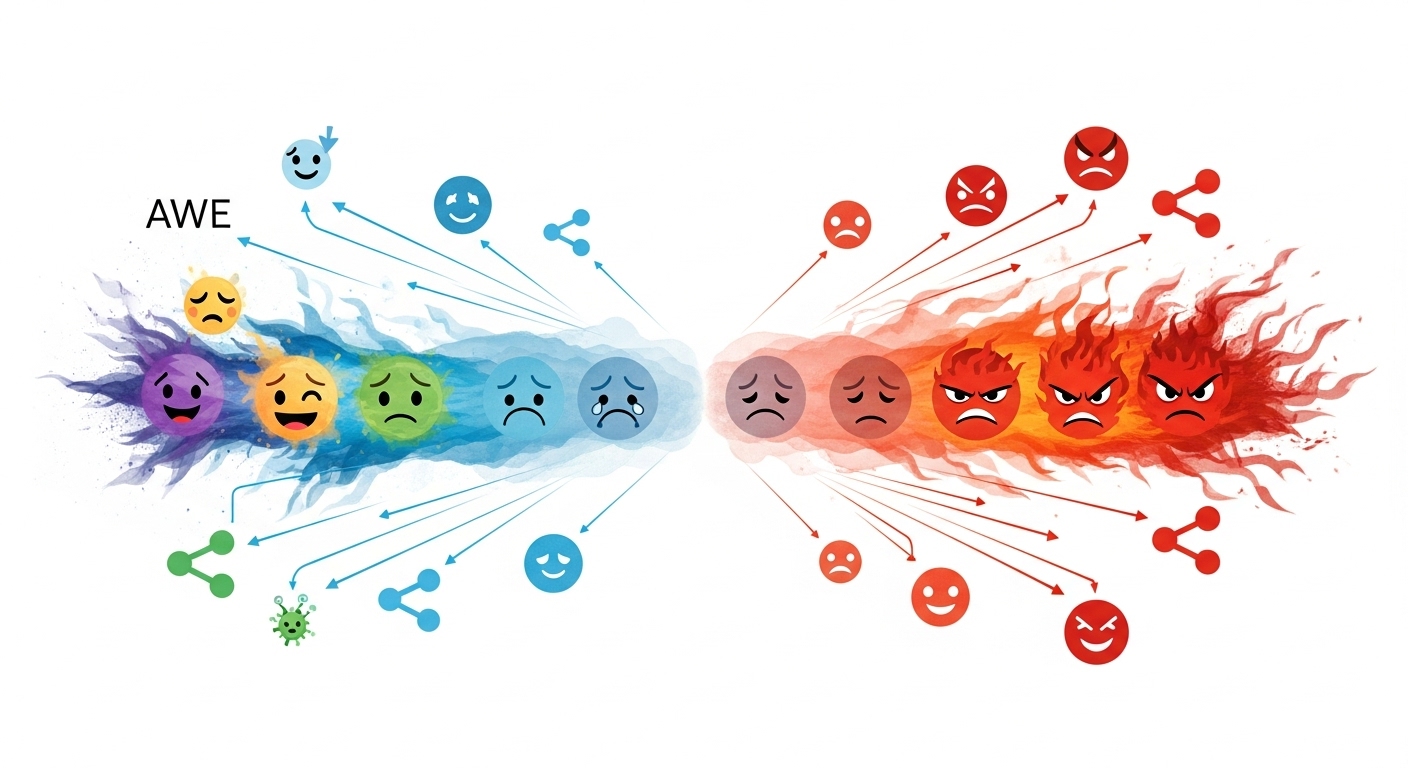Virality: Cognitive Biases & Digital Tactics for Sharing
Executive Summary
Content virality is not a game of chance but a predictable outcome of leveraging deep-seated cognitive biases and psychological triggers. This report deconstructs the science behind sharing, from the primary role of high-arousal emotions to the reinforcing power of social dynamics. The most effective viral content is engineered to allow audiences to participate in a shared experience, signal their identity, and close an emotional or informational gap. This framework, grounded in psychological research, provides a systematic approach for creating deeply resonant and organically shareable content. However, the very principles that drive virality—such as the anxiety of the Fear of Missing Out (FOMO) and the drive to resolve a curiosity gap—carry ethical risks. A sustainable, modern marketing strategy must distinguish between genuine influence and manipulative tactics that erode trust, prioritizing long-term brand equity over short-term metrics.
1. The Psychological Foundations of Virality: An Analytical Framework
1.1. The Engine of Virality: The Power of High-Arousal Emotions
The fundamental driver of social transmission is not simply information, but emotion. Content that evokes a strong emotional response is significantly more likely to be shared than neutral or mundane material. This phenomenon is rooted in a physiological state known as emotional arousal. Arousal refers to the intensity of an emotion, a state of mobilization that compels an individual to act and communicate.
Research has consistently shown that content sparking high-arousal emotions—whether positive (awe, joy, amusement, excitement) or negative (anger, anxiety, disgust)—is significantly more viral than content that is low-arousal or deactivating.
The implications of this extend beyond simple emotional categories. Low-arousal emotions, such as sadness or contentment, do not create the same urgent impulse to share, and thus content eliciting these feelings is far less likely to spread.
The true determinant of virality is not the valence (positive or negative) but the activation level. For instance, a news article designed to elicit high-arousal anxiety might spread more effectively than one that evokes low-arousal sadness, despite both being negative in valence.
This finding challenges the conventional wisdom that only positive content can go viral. This focus on arousal reveals a critical nuance: the paradox of virality. This phenomenon highlights that content which is widely shared is not always widely liked.

The reason for this lies in the nature of sharing high-arousal negative content. When a person shares something that makes them angry or anxious, the act is often not an endorsement but a form of emotional regulation and social validation.
People share outrage to find others who feel the same, to build solidarity against a perceived injustice, or to instigate a call to action. The content is not “liked,” but it is deeply “felt” and therefore acted upon. This dynamic provides a clear explanation for why campaigns and content that tap into public frustration or outrage can spread so rapidly, as the share becomes a powerful signal of a person’s values and beliefs.
The following table visually represents the relationship between emotional arousal and sharing propensity, providing a clear framework for understanding this foundational principle.
| Emotion | Valence | Arousal | Sharing Propensity | Examples |
|---|---|---|---|---|
| Awe | Positive | High | High | Stunning natural videos, inspirational stories, unexpected breakthroughs. |
| Amusement | Positive | High | High | Humorous memes, comedic skits, witty commentary. |
| Joy | Positive | High | High | Uplifting news, celebratory moments, heartwarming reunions. |
| Anger | Negative | High | High | Stories of injustice, political outrage, righteous indignation. |
| Anxiety | Negative | High | High | Urgent news alerts, safety concerns, suspenseful content. |
| Sadness | Negative | Low | Low | Melancholy stories, tales of loss, tragic news. |
| Contentment | Positive | Low | Low | Relaxing visuals, peaceful scenes, comforting anecdotes. |
1.2. The Social Drive: Perceived Utility and Identity Signaling
Beyond the emotional impulse, content sharing is fundamentally a social act. People frequently share content that they perceive as having “practical utility” with a “low information cost“. This content provides high value with minimal processing effort. The motivation is often to appear knowledgeable or altruistic, providing useful information like life hacks, tactical advice, or surprising data to one’s social network.
A more profound driver, however, is the concept of “identity signaling“. In an online environment where an individual’s presence is a curated performance, the content they share serves as a form of social currency. People select content that makes them look intelligent, funny, or informed, or that aligns with their personal values and aspirations.
A person’s online identity is defined by the content they share, the groups they join, and the people they follow. This applies to a wide range of content, from music preferences that signal group membership to political memes that act as a form of performative politics and group allegiance. The act of sharing becomes a badge of belonging, a way to publicly express one’s in-group affiliation and differentiate oneself from others.
This understanding of identity signaling is not merely a standalone principle; it is a foundational layer that amplifies and contextualizes all other psychological triggers. For example, the “bandwagon effect,” a core component of social proof, is not just about following a random crowd, but about joining the crowd of one’s in-group. The persuasive power of social proof is most potent when the evidence of popularity comes from a person’s peers or those with a similar social identity. Similarly, the anxiety of FOMO is not just about missing an event; it is about missing a shared experience that reinforces a core group identity. The fear stems from the possibility of being excluded from the group and losing a sense of belonging.
Ultimately, a truly viral campaign doesn’t just trigger an emotion or a cognitive bias in isolation; it offers the audience a psychological reason to share that content. The content becomes a vehicle for expressing a desired identity or reinforcing a sense of community.
2. A Deep Dive into Core Psychological Triggers
2.1. Social Proof: The Power of the Crowd
Social proof is a psychological phenomenon where people mirror the actions and decisions of others to determine the correct course of action. In the digital sphere, this manifests as the “bandwagon effect,” where people are more likely to engage with content that is already popular. When a post has a high number of likes, shares, or comments, it is instinctively perceived as more credible and valuable. This creates a powerful feedback loop where popularity begets more popularity. The “wisdom of the crowd” serves as a mental shortcut in an overwhelming digital environment, reducing decision-making anxiety for consumers.
For marketers and content creators, leveraging social proof is a powerful way to build trust and credibility. User-Generated Content (UGC) is a key tactic. Encouraging customers to share photos and videos using branded hashtags creates an authentic ecosystem of trust that traditional ad copy cannot capture.
Similarly, influencer and expert endorsements are a powerful form of social proof. An audience is more likely to trust recommendations from people who share their demographics, interests, or values than from distant celebrities.
Finally, displaying quantifiable metrics like follower counts (“Over 1 million satisfied customers!”), live purchase notifications, or testimonials creates a sense of popularity and reassures potential customers that they are making the right choice.
2.2. Fear of Missing Out (FOMO): The Psychology of Scarcity
FOMO is a pervasive apprehension that others might be having rewarding experiences from which one is absent. It is a relatively new phenomenon, intrinsically linked to the “round-the-clock nature of social media platforms,” which constantly highlight others’ activities and popularity. The anxiety stems from a fundamental need to belong and a fear of social exclusion. The compulsion to constantly check social media stems from a desire to stay continually connected and not fall behind.
Marketers and content creators can strategically engineer FOMO to drive immediate action. Tactics include creating a sense of scarcity and urgency with limited-time offers, flash sales, and low-stock alerts. This sense of urgency shortens the decision-making process and encourages a quicker conversion.
Similarly, offering exclusive access to a select group of customers, such as early entry to a sale or limited-edition items, makes them feel special and privileged, appealing to their desire to be ahead of the crowd.
Real-time updates, such as pop-ups showing recent purchases or low stock warnings, create immediate pressure on a consumer to act before an opportunity disappears.
However, the use of FOMO is a delicate ethical tightrope. The manipulative use of this psychological trigger can have significant negative consequences for the audience, including social anxiety, loneliness, and compulsive behaviors. The constant exposure to the “edited lives of others” can trigger social comparison, leading to feelings of inferiority and a vicious cycle of dissatisfaction and compulsive checking.
This highlights a crucial distinction between ethical persuasion and manipulation.
Ethical influence provides value and information to aid rational decision-making, appealing to a customer’s legitimate needs and empowering them to make an informed choice. Manipulation, conversely, uses deceptive or coercive tactics that subvert a consumer’s rational decision-making and exploit their vulnerabilities, without concern for their well-being. The long-term damage of such tactics, including the erosion of brand trust and reputation, far outweighs any short-term gains.
2.3. The Curiosity Gap: The Drive for Information Closure
The curiosity gap is the psychological space between what a person knows and what they want to know. This perceived gap creates a sense of deprivation and a compelling drive to seek out the missing information to alleviate cognitive tension. This drive is further reinforced by the release of dopamine in the brain’s reward system when the gap is closed. A related principle, the Zeigarnik effect, explains why people remember uncompleted tasks or narratives better than completed ones. This is the fundamental cognitive science behind narrative cliffhangers and “wait for it” hooks in short-form video.
Marketers can tactically leverage the curiosity gap to craft irresistible hooks and narratives. This is commonly seen in headlines that pose an intriguing question or hint at a surprising benefit without giving away the answer. Examples include, “The Simple Storytelling Trick That Can Transform Your Writing” or “What if I told you the most productive people don’t use to-do lists at all?”. Another tactic is to use visual teasers that hint at a reveal without showing the full picture, a foundational technique in short-form video content. Finally, content can be structured using a principle of progressive disclosure, withholding key information until later in the article or video to maintain narrative tension and keep the audience engaged until the very end.
However, the curiosity gap can easily devolve into unethical “clickbait”. Clickbait headlines are engineered to deliberately mislead, exploit biases, and compel clicks without providing the promised value. This practice breaks a fundamental promise to the audience. When readers are repeatedly lured by a hook that fails to deliver, they stop believing the promises. The damage isn’t just to one piece of content but to the brand’s overall credibility. This results in a loss of consumer trust, which is far more valuable than a few extra clicks. The race for clicks reflects a deeper conflict between profit and principle; the lasting solution is not a technical fix, but a cultural shift toward ethical standards, transparency, and a commitment to providing genuine value to the audience.
3. Case Studies: Psychological Principles in Practice
3.1. Memes and the Distillation of Identity
Case Study: The “Distracted Boyfriend” Meme
The “Distracted Boyfriend” meme went viral because it visually captured a universal human experience of being tempted by something new. The stock photograph provided a simple, accessible, and instantly recognizable template for users to express a range of complex ideas, from generational attitudes to political loyalties, with minimal effort. This allowed people to comment on a cultural moment or express a complex idea in a single image. The act of sharing the meme served as a form of social currency, allowing the user to signal their humor, wit, or political affiliation and reinforce their identity within their social circle.
Case Study: Political Memes
Political memes are a powerful example of identity signaling in action. They are not merely funny images; they function as signals of allegiance to a specific political group or ideology. They leverage high-arousal emotions like humor and outrage to create an emotional connection and reinforce in-group identity within echo chambers. These memes are highly shareable because they allow users to participate in a shared narrative and signal their values to their community, making political discourse a form of performance.
3.2. Short-Form Video (Reels & TikTok)
Case Study: Duolingo’s Viral TikTok Persona
Duolingo’s success on TikTok was not a product of traditional promotion. The brand’s team leveraged the community’s pre-existing jokes about its passive-aggressive push notifications to create an authentic, humorous persona for its mascot, Duo. By embracing an absurd and relatable “TikTok native” tone, the brand forged a strong emotional connection with its audience, turning casual viewers into loyal followers. The content didn’t directly sell the product but made the brand memorable and “fun,” ensuring that when a user thought about language learning, they would remember Duolingo.
Case Study: The Psychological Drivers of Short-Form Trends
Viral Reels and TikToks are expertly engineered to leverage psychological triggers. They grab attention within the first few seconds using a curiosity gap (“wait for it” captions) and a compelling hook. This builds anticipation and increases watch time, which the platforms’ algorithms reward. The rapid-fire, high-arousal content provides instant gratification and dopamine hits, encouraging a continuous scroll. The fast-moving nature of these trends, dances, and challenges leverages FOMO, motivating users to participate to avoid being left out of the cultural conversation.
3.3. Viral Campaigns: Blending Triggers for Mass Engagement
Case Study: The ALS Ice Bucket Challenge
This campaign was a masterclass in leveraging social dynamics. The public nature of the challenge, which involved filming oneself being doused with ice water, created an immense social proof effect where participation signaled belonging and altruism. The nomination mechanic tapped into social reciprocity, compelling people to participate to repay a social debt and avoid being seen as an outcast. The time-sensitive nature of the challenge created FOMO, and its low barrier to entry and competitive element fueled widespread engagement, turning a simple act into a global movement.
Case Study: Spotify Wrapped
Spotify Wrapped masterfully blends data storytelling with psychological triggers to create an annual viral sensation. It transforms a user’s private listening data into a shareable “identity badge,” fulfilling the deep-seated desire for social currency. Users are motivated to share their results to signal their unique music tastes and personal identity to their friends and followers. By becoming an annual cultural moment, the campaign creates massive FOMO, as non-users are compelled to sign up just to participate in the social conversation and avoid being excluded from the shared experience.
Case Study: Dove’s “Real Beauty Sketches”
This campaign succeeded by tapping into a universal emotional core: women’s anxiety about their appearance. It used a narrative that evoked powerful awe and empathy, while also leveraging social comparison theory in a positive way by featuring “real women” that the audience could relate to. Sharing the video became an act of social currency, allowing users to signal their support for a progressive, values-driven movement that challenged conventional beauty standards.
3.4. Learning from Failure: When Virality Backfires
Viral campaigns can fail spectacularly when they misjudge cultural context or audience perception. The Pepsi “Live for Now” ad and the Adidas Boston Marathon email are prime examples. The Pepsi ad, which attempted to ride the wave of a serious social movement, trivialized a deeply felt and sensitive issue by portraying a protest as a party that could be resolved with a soda can. The Adidas email used the word “survived” in its subject line to congratulate runners, failing to consider the tragic history of the Boston Marathon bombing. These campaigns demonstrate a fundamental disconnect between a brand’s intent and the audience’s emotional reality.
When a brand attempts to leverage a cultural moment without a genuine understanding or authentic connection to the issue, it is perceived as insincere and exploitative. This triggers a high-arousal negative emotion—outrage—that is highly shareable and causes the campaign to backfire. The most valuable lesson from these failures is that virality amplifies mistakes just as quickly as it amplifies successes. Context matters more than intent. Building trust and avoiding brand fails requires thorough audience research, cultural awareness, and a pre-publication review process that considers how a message could be misinterpreted when viewed in isolation.
4. The Virality Toolkit: A Strategic Framework for Content Creators
4.1. From Bias to Tactic: A Quick-Reference Guide
The following table synthesizes the psychological principles discussed and maps them to practical digital tactics, providing a concise toolkit for creating shareable content.
| Psychological Principle | Foundational Concept | Digital Tactics |
|---|---|---|
| Emotional Arousal | High-intensity emotions compel action. | Emotion-specific headlines, emotional storytelling, sound and music cues. |
| Social Proof | People follow the actions of others. | User testimonials, influencer collaborations, displaying social metrics (likes, shares, followers). |
| Fear of Missing Out (FOMO) | Fear of social exclusion and lost opportunities. | |
| Curiosity Gap | The drive to close a gap in knowledge. | Intriguing headlines, visual teasers, cliffhangers, progressive disclosure. |
| Identity Signaling | Content is a public expression of self. | Provide shareable moments that align with audience values, leverage in-jokes, create a sense of belonging. |
The Art of Ethical Influence: Building Shareable Content with Integrity
The most powerful psychological triggers can be wielded for both positive and negative ends. A key distinction in modern marketing is the line between ethical influence and manipulation. Ethical influence provides value and information to aid a consumer’s rational decision-making, appealing to their legitimate needs and empowering them to make an informed choice. Manipulation, conversely, uses deceptive or coercive tactics that subvert a consumer’s rational decision-making and exploit their vulnerabilities, without concern for their well-being. The future of sustainable marketing requires operating with transparency and a genuine commitment to creating content that provides value and builds trust. The long-term damage of manipulative tactics—eroding trust and brand reputation—far outweighs any short-term gains.
The following table provides a comparative analysis of successful versus failed campaigns, illustrating how the principles outlined in this report lead to drastically different outcomes based on their application.
| Campaign Example | Core Triggers Leveraged | Analysis of Outcome |
|---|---|---|
| ALS Ice Bucket Challenge | Social Proof, Reciprocity, FOMO | Success. Leveraged positive social dynamics and low barriers to entry to create a viral movement and massive fundraising. |
| Spotify Wrapped | Identity Signaling, Social Currency, FOMO | Success. Expertly turned personal data into a shareable identity badge, creating an annual cultural moment that builds loyalty and generates FOMO among non-users. |
| Dove’s “Real Beauty Sketches” | Emotion (Awe), Social Comparison | Success. Tapped into a universal emotional core with a powerful narrative that empowered the audience and encouraged sharing as an act of social signaling. |
| Pepsi’s “Live for Now” Ad | High-Arousal Emotion, Trend-Riding | Failure. Attempted to leverage a serious social movement for profit without an authentic connection. The message was perceived as tone-deaf and insincere, causing widespread outrage. |
| Adidas’ Boston Marathon Email | High-Arousal Emotion (Fear) | Failure. Used a word (“survived”) that was culturally insensitive in the context of a past tragedy. The disconnect between intent and audience reality led to a swift and severe backlash. |
| Dove’s “Real Beauty Bottles” | Emotion (Positivity) | Failure. Failed to deliver on its core brand promise with a product that audiences perceived as insulting and out of touch. Backlash was immediate and widespread. |
Table 3: Case Study Analysis: Psychological Triggers in Viral Campaigns
Conclusion
Virality is a science, not a mystery. By understanding the core psychological triggers—emotional arousal, social proof, the fear of missing out, and the curiosity gap—and the foundational role of identity, content creators can systematically engineer their content for social transmission. The most effective content provides audiences with a compelling reason to share that is rooted in their emotional and social needs.
However, the true mastery of this science lies not just in the ability to create shareable content but in the wisdom to do so ethically. The psychological tools that drive virality are a powerful force, and with that power comes a profound responsibility. A sustainable strategy for the future of marketing requires a shift from manipulative tactics that exploit vulnerabilities to an authentic approach that provides genuine value, respects audience autonomy, and builds lasting trust. This is the only way to build a brand that is not just popular, but truly enduring.
📚 For more insights, check out our digital marketing strategies in Nepal.


